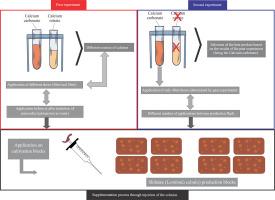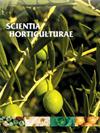Liquid calcium supplementation between flushes increases shiitake yield
IF 3.9
2区 农林科学
Q1 HORTICULTURE
引用次数: 0
Abstract
Practical and technological innovations in mushroom production is of paramount importance to ensure enhanced yields and promote the development of mushroom cultivation on a global scale. The purpose of this study was to evaluate of Lentinula edodes with liquid supplementation of two calcium sources at different dose and application intervals. The experiment was divided into two trials, with the first aimed at assessing different doses of calcium carbonate and calcium nitrate applied either before or after primordia induction. The second trial involved applications interspersed throughout the production flushes, ranging from one application to four during the crop cycle. In the first trial, it was observed that the dose of 40 ml of calcium carbonate applied before the induction of primordia yielded the highest returns compared to other dosages. This source of calcium and dose were selected for the second trial. In the second trial, it was found that a single application before the second flush, double applications in the first and second flushes or in the first and third flushes, and triple applications before the first, third, and fourth flushes, as well as in the second, third, and fourth flushes, provided an increase in yield of up to 20 %. Thus, it is concluded that the use of calcium supplementation during the cultivation of L. edodes was effective, proving to be a promising technique for commercial cultivation.

潮间带液体钙补充剂可提高香菇产量
蘑菇生产的实践和技术创新对于确保提高产量和促进全球蘑菇栽培的发展至关重要。本研究的目的是评估在液体中补充两种钙源(不同的剂量和施用间隔)对牛肝菌的影响。试验分为两项,第一项旨在评估在诱导初生蘑菇之前或之后施用不同剂量的碳酸钙和硝酸钙。第二项试验则是在整个生产过程中穿插施用,在作物周期内施用一次到四次不等。在第一项试验中,与其他剂量相比,在诱导初生茎之前施用 40 毫升碳酸钙的收益最高。第二次试验选择了这种钙源和剂量。在第二次试验中发现,在第二次潮涌前施用一次,在第一次和第二次潮涌或第一次和第三次潮涌时施用两次,在第一次、第三次和第四次潮涌前以及第二次、第三次和第四次潮涌时施用三次,可使产量增加 20%。因此,可以得出结论,在栽培莱菔子期间使用钙补充剂是有效的,证明是一种很有前途的商业栽培技术。
本文章由计算机程序翻译,如有差异,请以英文原文为准。
求助全文
约1分钟内获得全文
求助全文
来源期刊

Scientia Horticulturae
农林科学-园艺
CiteScore
8.60
自引率
4.70%
发文量
796
审稿时长
47 days
期刊介绍:
Scientia Horticulturae is an international journal publishing research related to horticultural crops. Articles in the journal deal with open or protected production of vegetables, fruits, edible fungi and ornamentals under temperate, subtropical and tropical conditions. Papers in related areas (biochemistry, micropropagation, soil science, plant breeding, plant physiology, phytopathology, etc.) are considered, if they contain information of direct significance to horticulture. Papers on the technical aspects of horticulture (engineering, crop processing, storage, transport etc.) are accepted for publication only if they relate directly to the living product. In the case of plantation crops, those yielding a product that may be used fresh (e.g. tropical vegetables, citrus, bananas, and other fruits) will be considered, while those papers describing the processing of the product (e.g. rubber, tobacco, and quinine) will not. The scope of the journal includes all horticultural crops but does not include speciality crops such as, medicinal crops or forestry crops, such as bamboo. Basic molecular studies without any direct application in horticulture will not be considered for this journal.
 求助内容:
求助内容: 应助结果提醒方式:
应助结果提醒方式:


